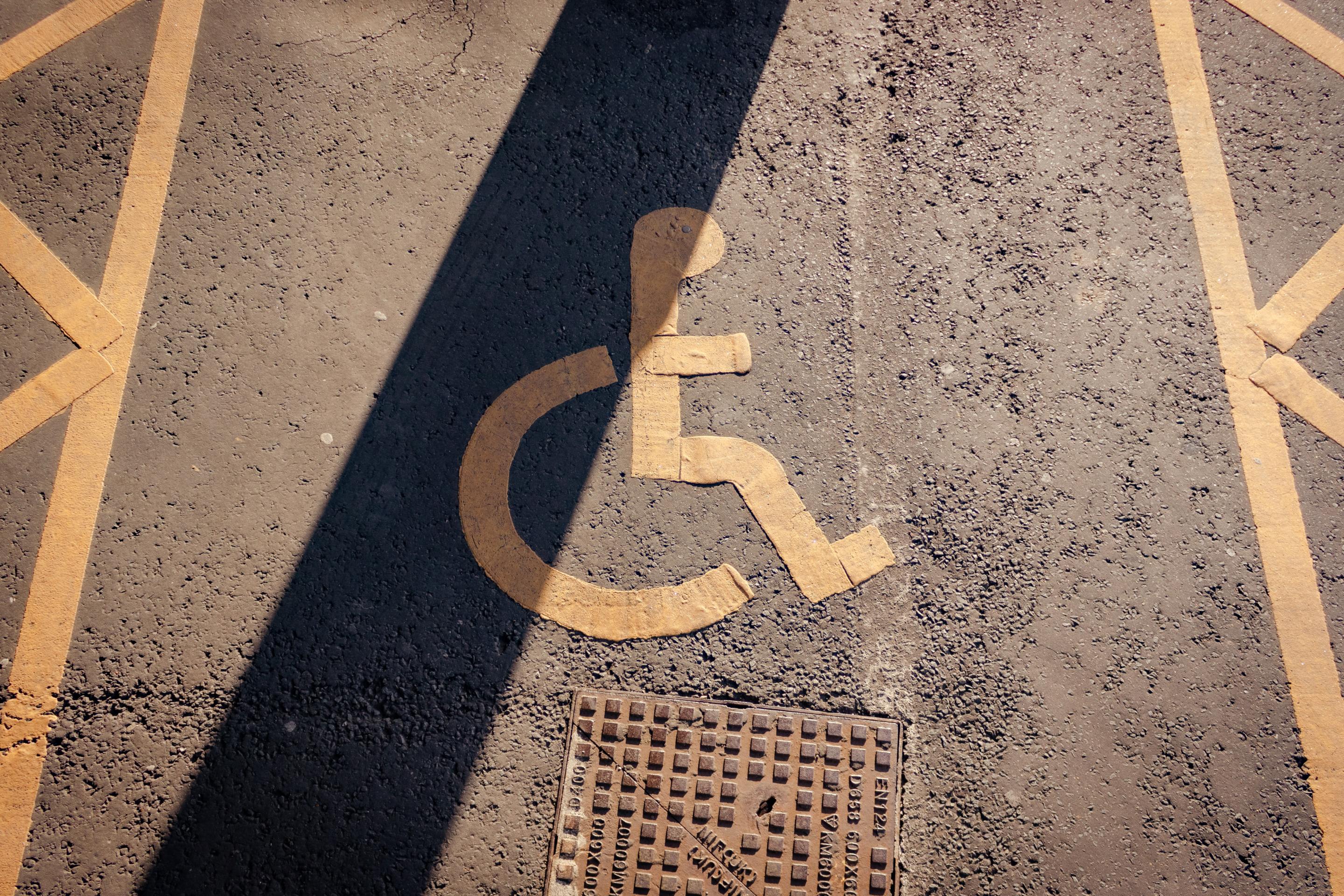What Parking Reform Means for People With Disabilities
12:01 AM EDT on March 22, 2023

Photo: Jakub Pabis, CC
Practically every day, there's a new headline about a new effort in a U.S. city to reform its auto-centric parking policies — and practically every time Streetsblog covers it, we get an email that asks what people with disabilities will do in a world with no accessible parking at all.
Let's be clear: any transportation proposal that does not center the needs of people with mobility challenges has no place in the movement to end car dependency. And indeed, particularly in the context of a car-dominated community with few other options to get around, accessible parking is often a profoundly important need that must be met.
In practice, though, the goals of most parking reformers rarely conflict with those parking needs — and some even argue that without rethinking our current approach to car storage through an anti-ableist lens, we'll never build a world where all people with mobility challenges can truly thrive.
"I don’t think reducing parking is a threat," said Steve Wright, a planner, writer and educator in Universal Design. "I think it’s about connecting the dots on mobility, whether it’s rolling in your wheelchair a few blocks to work, or to the accessible bus stop, or to the accessible parking space."
Here are three myths about what parking reform could mean for people with mobility challenges, and how to bust them.
Myth #1: Everyone with mobility challenges relies on driving
Many Americans with mobility challenges use an automobile to get around. A whopping 39.4 percent of them, though, report that they don't personally drive at at all, compared to just 8.3 percent of Americans without disabilities — and even when they do, they drive for about 9 percent fewer trips than their able-bodied counterparts.
Reactionary conversations about parking reform often gloss over that fact — and erase the needs of blind and many visually impaired people, folks with intellectual disabilities and other health conditions that make driving challenging or unsafe, and those who simply don't want or can't afford to operate an automobile. Cost can be a particularly steep barrier for wheelchair users, for whom accessible vans can cost from $40,000 to $100,000, with little public support available.
And even those statistics don't capture the complex lived realities of people with mobility challenges, who are too often held up as a monolithic symbol to advance the anti- and pro-parking reform agendas without giving them a direct say in local parking decisions that effect them the most — not to mention the transit, walking, and biking policies that also influence how they get around.
“Within both car-centrism and new urbanism, there's ableism on either side — because we live in an ableist society," said disability advocate Megan Lynch in a must-watch September panel on disability and parking reform. "It's not something that one political bent has a monopoly on. ... Car-centered people leap in and say, ‘We can’t do [parking reform] because disabled people need [a place to park their cars],' and then people on the other side say, ‘Not everyone can afford a car, and disabled people make less money' – which is often true. But we’re not really talking to actual disabled people.”
Wright says those assumptions are particularly pervasive in the built environment professions.
"As much as I love and admire the planning industry, I think it’s doing a horrible job of seeking input from people with disabilities," he adds. "If you don’t have people with disabilities working on your staff, you’re going to presume a lot of things [about how they live and move] that just aren’t true."
Myth #2: Parking reform = fewer accessible spots
According to the advocacy group Parking Reform Network, the movement to change America's approach to car storage can be roughly defined as advocating for "the use of policies and activism to discourage the building of too much parking supply and encourage more equitable, efficient and sustainable management of existing parking supply," typically by changing how existing spaces are priced or rescinding government policies that require developers to build more garages and lots than they'll ever actually need.
In the public imagination, though, the word "reform" sometimes morphs into an image of a cabal of cackling urbanists bulldozing van-accessible spots to make room for bike lanes for able-bodied people in Lyrca, or banning the building of new spots unto eternity.
"What we've seen in practice is that when we eliminate these mandates, not a whole lot changes," said Tony Jordan, president of the Network. "A lot of the development that still comes along has some parking — and usually, the first space that's built has to be an accessible space under ADA standards.
Jordan adds that the broader menu of parking reform strategies can actually direct developers to build more parking for people with mobility challenges, while simultaneously improving mobility alternatives for people who don't really need cars. That might include, say, mandating additional van-accessible curbside spots at places frequented by people who use wheelchairs, transforming parking spots into bus stops for accessible transit vehicles, as well as better bike parking that can accommodate adaptive cycles and e-bikes, better enforcement of placard abuse to prevent people without mobility challenges from using spots not meant for them, and so much more.
"It's not really about building a world without parking spaces," Jordan adds. "It's about building a world without car dependency, and giving space that's usually devoted to cars to things other than cars."
Myth #3: Our parking status quo is working great for people with disabilities, especially if they drive
If ample parking were all it took to make the world comprehensively accessible to people with mobility challenges, America, which has an estimated eight parking spots for every car on the road, would be among the most accessible nations on Earth.
Very few of those spots, though, are actually usable by the people who need them most — and the sheer glut of autocentric infrastructure that surrounds them can make life outside the parking lot significantly harder for people with disabilities, too.
In a 2021 article for Strong Towns, writer Daniel Herriges noted that "surprisingly little of the existing parking supply is reserved for people with disabilities," pointing out that the parking standards outlined in Americans With Disability Act amount to just "2 to 4 percent of spaces which must be accessible" on privately built lots, with a thin patchwork of state and local laws providing a minuscule supply of accessible spaces on the street.
Meanwhile, even that tiny handful of spaces are surrounded by oceans of asphalt dominated by able-bodied drivers — and not just asphalt poured for parking facilities, but also an endless supply of ever-wider and ever-faster roads that make getting anywhere outside a parking spot perilous. A 2015 study found that wheelchair users were 36 percent more likely to die while traveling outside of an automobile, and people with other disabilities face heightened risks, too — and that's to say nothing of the deadly consequences that climate change are already have on people with mobility challenges.
Parking and roads, of course, are almost universally free to use or severely underpriced to the driver, regardless of their disability status — and when it comes to parking, that means the true costs of lots are typically absorbed by the rents on adjacent buildings whether or not residents actually use them. The Parking Reform network estimates that "conventional parking minimums can increase the rent or mortgage required for an apartment or house by $200 to $500 per month" — a particularly steep premium for households that already struggle to find accessible housing options they can afford. The poverty rate for U.S. adults with disabilities is more than twice the rate for adults without them.
"We're talking about a population that, on average, has less housing supply that they can comfortableylive in, and lower incomes as a whole," added Jordan. "When parking is required, we build less housing because of the space and the cost that it takes up, and the impacts of that are mostly going to be felt in places that would otherwise be accessible 15-minute cities."
Jordan stresses that until we shift the auto-centric status quo, it will be challenging to provide Americans with a variety of accessible mobility options that make it possible to negotiate conflicts over competing access needs. And doing that starts with centering the disability community itself.
"The main thing we need to do is to find and talk to people across the entire spectrum of people with disabilities," Jordan adds. "They have existing needs and future dreams and problems [we can solve]. And I believe we can without adding a bunch of unnecessary parking. We just have to want to."
Kea Wilson is editor of Streetsblog USA. She has more than a dozen years experience as a writer telling emotional, urgent and actionable stories that motivate average Americans to get involved in making their cities better places. She is also a novelist, cyclist, and affordable housing advocate. She previously worked at Strong Towns, and currently lives in St. Louis, MO. Kea can be reached at kea@streetsblog.org or on Twitter @streetsblogkea. Please reach out to her with tips and submissions.
Read More:
Stay in touch
Sign up for our free newsletter
More from Streetsblog USA
The 30% of Non-Driving Americans Must Form a Movement: A Conversation with Anna Zivarts
"At the end of the day, there are going to be folks who still can't drive and can't afford to drive — and there are still going to be a lot of us."
Thursday’s Headlines Fight a Suburban War
The way Politico lays out the battle lines, it's not just drivers versus transit users, but urban transit users versus suburban ones.
How Car-Centric Cities Make Caring For Families Stressful — Particularly For Women
Women do a disproportionate share of the care-related travel their households rely on — and car-focused planning isn't making matters easier.
Wednesday’s Headlines Build Green
A new bill dubbed "Build Green" would replace many of the climate-friendly elements Sen. Joe Manchin insisted on stripping from the Inflation Reduction Act.
E-Bikes and Creating Financially Sustainable Bike Share Programs
The number of customers using bike share in the U.S. and Canada is now at an all-time high thanks to e-bikes.




